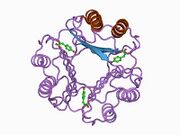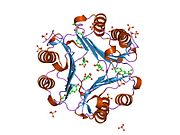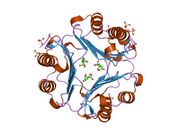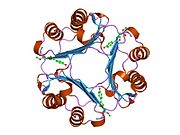Biology:Macrophage migration inhibitory factor
 Generic protein structure example |
| Macrophage migration inhibitory factor (MIF) | |||||||||
|---|---|---|---|---|---|---|---|---|---|
| Identifiers | |||||||||
| Symbol | MIF | ||||||||
| Pfam | PF01187 | ||||||||
| InterPro | IPR001398 | ||||||||
| PROSITE | PDOC00892 | ||||||||
| SCOP2 | 1mif / SCOPe / SUPFAM | ||||||||
| |||||||||
Macrophage migration inhibitory factor (MIF), also known as glycosylation-inhibiting factor (GIF), L-dopachrome isomerase, or phenylpyruvate tautomerase is a protein that in humans is encoded by the MIF gene.[1][2] MIF is an important regulator of innate immunity.[3] The MIF protein superfamily also includes a second member with functionally related properties, the D-dopachrome tautomerase (D-DT).[4] CD74 is a surface receptor for MIF.[5]
Bacterial antigens stimulate white blood cells to release MIF into the blood stream.[6] The circulating MIF binds to CD74 on other immune cells to trigger an acute immune response. Hence, MIF is classified as an inflammatory cytokine. Furthermore, glucocorticoids also stimulate white blood cells to release MIF and hence MIF partially counteracts the inhibitory effects that glucocorticoids have on the immune system. Finally trauma activates the anterior pituitary gland to release MIF.[7]
Structure
Macrophage migration inhibitory factor assembles into a trimer composed of three identical subunits. Each of these monomers contain two antiparallel alpha helices and a four-stranded beta sheet. The monomers surround a central channel with 3-fold rotational symmetry.[8][9]
Response to injury
Cytokines play an important role in promoting wound healing and tissue repair. Cell injury results in MIF release which then interacts with CD74. MIF-CD74 signaling activates pro-survival and proliferative pathways that protects the host during injury.[10]
Enzymatic activity
MIF contains two motifs with catalytic activity. The first is a 27 amino acid motif located at the N-terminus functions as a phenylpyruvate tautomerase that can catalyze the conversion of 2-carboxy-2,3-dihydroindole-5,6-quinone (dopachrome) into 5,6-dihydroxyindole-2-carboxylic acid (DHICA).[11][12] MIF also contains a Cys-Ala-Leu-Cys catalytic site between residues 57 and 60 that appears to function as a disulfide reductase.[13]
Function
This gene encodes a lymphokine involved in cell-mediated immunity, immunoregulation, and inflammation.[14][15][16] MIF plays a role in the regulation of macrophage function in host defense through the suppression of anti-inflammatory effects of glucocorticoids.[16][17][18] This lymphokine and the JAB1 protein form a complex in the cytosol near the peripheral plasma membrane, which may indicate a role in integrin signaling pathways.[19]
Mechanism of action
MIF binds to CD74,[20] inducing its phosphorylation and the recruitment of CD44 which then activates non-receptor tyrosine kinases, leading ultimately to extracellular signal-regulated kinase phosphorylation.[21] In addition to ERK, stimulation of CD74 activates other signaling pathways such PI3K-Akt, NF-κB, and AMP-activated protein kinase (AMPK) pathways.[22]
Interactions
Macrophage migration inhibitory factor has been reported to interact with:
Clinical significance
MIF is a potential drug target for sepsis, rheumatoid arthritis, and cancer.[36][37]
Parasite-produced MIF homologs
Multiple protozoan parasites produce homologs MIF that have similar inflammatory functions to human MIF, and play a role in their pathogenesis, invasion and immune evasion.[38][39] A preclinical study showed that blocking parasite MIF improves outcome in severe protozoan infections.[40] Examples of protozoans with MIF homologs that have been reported:
- Entamoeba histolytica,[41]
- Plasmodium falciparum,[42]
- Toxoplasma gondii,[43]
- Leishmania,[44]
- Trichomonas vaginalis.[45]
References
- ↑ "Molecular cloning of a cDNA encoding a human macrophage migration inhibitory factor". Proceedings of the National Academy of Sciences of the United States of America 86 (19): 7522–6. October 1989. doi:10.1073/pnas.86.19.7522. PMID 2552447. Bibcode: 1989PNAS...86.7522W.
- ↑ "Genomic cloning of mouse MIF (macrophage inhibitory factor) and genetic mapping of the human and mouse expressed gene and nine mouse pseudogenes". Genomics 27 (3): 405–11. June 1995. doi:10.1006/geno.1995.1070. PMID 7558020.
- ↑ "Macrophage migration inhibitory factor: a regulator of innate immunity". Nature Reviews. Immunology 3 (10): 791–800. October 2003. doi:10.1038/nri1200. PMID 14502271.
- ↑ "Role of MIF and D-DT in immune-inflammatory, autoimmune, and chronic respiratory diseases: from pathogenic factors to therapeutic targets". Drug Discovery Today 24 (2): 428–439. February 2019. doi:10.1016/j.drudis.2018.11.003. PMID 30439447.
- ↑ "Role of MIF Cytokine/CD74 Receptor Pathway in Protecting Against Injury and Promoting Repair". Frontiers in Immunology 11: 1273. 2020. doi:10.3389/fimmu.2020.01273. PMID 32655566.
- ↑ Barret, James (1980). Basic Immunology and its Medical Application (2 ed.). St.Louis: The C.V. Mosby Company. ISBN 978-0-8016-0495-9.
- ↑ "Macrophage migration inhibitory factor: controller of systemic inflammation". Critical Care 10 (2): 138. 2006. doi:10.1186/cc4899. PMID 16677407.
- ↑ "Crystal structure at 2.6-A resolution of human macrophage migration inhibitory factor". Proceedings of the National Academy of Sciences of the United States of America 93 (11): 5191–6. May 1996. doi:10.1073/pnas.93.11.5191. PMID 8643551.
- ↑ "MIF as a disease target: ISO-1 as a proof-of-concept therapeutic". Future Medicinal Chemistry 3 (1): 45–63. January 2011. doi:10.4155/fmc.10.281. PMID 21428825.
- ↑ "Role of MIF Cytokine/CD74 Receptor Pathway in Protecting Against Injury and Promoting Repair". Frontiers in Immunology 11: 1273. 2020. doi:10.3389/fimmu.2020.01273. PMID 32655566.
- ↑ "The immunoregulatory mediator macrophage migration inhibitory factor (MIF) catalyzes a tautomerization reaction". Molecular Medicine 2 (1): 143–9. January 1996. doi:10.1007/BF03402210. PMID 8900542.
- ↑ "Macrophage migration inhibitory factor elicits an angiogenic phenotype in human ectopic endometrial cells and triggers the production of major angiogenic factors via CD44, CD74, and MAPK signaling pathways". The Journal of Clinical Endocrinology and Metabolism 95 (12): E403-12. December 2010. doi:10.1210/jc.2010-0417. PMID 20829186.
- ↑ "Link between macrophage migration inhibitory factor and cellular redox regulation". Antioxidants & Redox Signaling 7 (9–10): 1234–48. 2005. doi:10.1089/ars.2005.7.1234. PMID 16115028.
- ↑ "Insight into the biology of macrophage migration inhibitory factor (MIF) revealed by the cloning of its cell surface receptor". Cell Research 16 (2): 162–8. February 2006. doi:10.1038/sj.cr.7310022. PMID 16474429.
- ↑ "ISO-1, a macrophage migration inhibitory factor antagonist, inhibits airway remodeling in a murine model of chronic asthma". Molecular Medicine 16 (9–10): 400–8. 2010. doi:10.2119/molmed.2009.00128. PMID 20485865.
- ↑ 16.0 16.1 "Macrophage CD74 contributes to MIF-induced pulmonary inflammation". Respiratory Research 10 (1): 33. May 2009. doi:10.1186/1465-9921-10-33. PMID 19413900.
- ↑ "The macrophage migration inhibitory factor-glucocorticoid dyad: regulation of inflammation and immunity". Molecular Endocrinology 21 (6): 1267–80. June 2007. doi:10.1210/me.2007-0065. PMID 17389748.
- ↑ "Thyroxine is a potential endogenous antagonist of macrophage migration inhibitory factor (MIF) activity". Proceedings of the National Academy of Sciences of the United States of America 108 (20): 8224–7. May 2011. doi:10.1073/pnas.1017624108. PMID 21536912. Bibcode: 2011PNAS..108.8224A.
- ↑ "Entrez Gene: MIF macrophage migration inhibitory factor (glycosylation-inhibiting factor)". https://www.ncbi.nlm.nih.gov/sites/entrez?Db=gene&Cmd=ShowDetailView&TermToSearch=4282.
- ↑ "MIF is a pituitary-derived cytokine that potentiates lethal endotoxaemia". Nature 365 (6448): 756–9. October 1993. doi:10.1038/365756a0. PMID 8413654. Bibcode: 1993Natur.365..756B.
- ↑ "CD44 is the signaling component of the macrophage migration inhibitory factor-CD74 receptor complex". Immunity 25 (4): 595–606. October 2006. doi:10.1016/j.immuni.2006.08.020. PMID 17045821.
- ↑ "Role of MIF Cytokine/CD74 Receptor Pathway in Protecting Against Injury and Promoting Repair". Frontiers in Immunology 11: 1273. 2020. doi:10.3389/fimmu.2020.01273. PMID 32655566.
- ↑ "The apoptosis-associated protein BNIPL interacts with two cell proliferation-related proteins, MIF and GFER". FEBS Letters 540 (1–3): 86–90. April 2003. doi:10.1016/S0014-5793(03)00229-1. PMID 12681488.
- ↑ "CD74 Signaling Links Inflammation to Intestinal Epithelial Cell Regeneration and Promotes Mucosal Healing". Cellular and Molecular Gastroenterology and Hepatology 10 (1): 101–112. 2020. doi:10.1016/j.jcmgh.2020.01.009. PMID 32004754.
- ↑ "MIF signal transduction initiated by binding to CD74". The Journal of Experimental Medicine 197 (11): 1467–76. June 2003. doi:10.1084/jem.20030286. PMID 12782713.
- ↑ "The role of macrophage migration inhibitory factor in Alzheimer's disease". Molecular Medicine 16 (3–4): 116–21. March 2010. doi:10.2119/molmed.2009.00123. PMID 20200619.
- ↑ "[Identification of the interactions between the truncated fragments of macrophage migration inhibitory factor and CD74 using a yeast two-hybrid system]" (in zh). Nan Fang Yi Ke da Xue Xue Bao = Journal of Southern Medical University 29 (12): 2383–6, 2390. December 2009. PMID 20034881.
- ↑ "Spinal macrophage migration inhibitory factor contributes to the pathogenesis of inflammatory hyperalgesia in rats". Pain 148 (2): 275–83. February 2010. doi:10.1016/j.pain.2009.11.011. PMID 20005040.
- ↑ "The crystal structures of macrophage migration inhibitory factor from Plasmodium falciparum and Plasmodium berghei". Protein Science 18 (12): 2578–91. December 2009. doi:10.1002/pro.263. PMID 19827093.
- ↑ "Interaction between parasite-encoded JAB1/CSN5 and macrophage migration inhibitory factor proteins attenuates its proinflammatory function". Scientific Reports 8 (1): 10241. July 2018. doi:10.1038/s41598-018-28625-1. PMID 29980718. Bibcode: 2018NatSR...810241G.
- ↑ "Intracellular action of the cytokine MIF to modulate AP-1 activity and the cell cycle through Jab1". Nature 408 (6809): 211–6. November 2000. doi:10.1038/35041591. PMID 11089976. Bibcode: 2000Natur.408..211K.
- ↑ "A functional heteromeric MIF receptor formed by CD74 and CXCR4". FEBS Letters 583 (17): 2749–57. September 2009. doi:10.1016/j.febslet.2009.07.058. PMID 19665027.
- ↑ "Restoration of contact inhibition in human glioblastoma cell lines after MIF knockdown". BMC Cancer 9: 464. December 2009. doi:10.1186/1471-2407-9-464. PMID 20038293.
- ↑ "Macrophage migration inhibitory factor (MIF) is necessary for progression of autoimmune diabetes mellitus". Journal of Cellular Physiology 215 (3): 665–75. June 2008. doi:10.1002/jcp.21346. PMID 18064633.
- ↑ "Ribosomal protein S19 interacts with macrophage migration inhibitory factor and attenuates its pro-inflammatory function". The Journal of Biological Chemistry 284 (12): 7977–85. March 2009. doi:10.1074/jbc.M808620200. PMID 19155217.
- ↑ "Macrophage migration inhibitory factor (MIF): mechanisms of action and role in disease". Microbes and Infection 4 (4): 449–60. April 2002. doi:10.1016/S1286-4579(02)01560-5. PMID 11932196.
- ↑ "MIF, a controversial cytokine: a review of structural features, challenges, and opportunities for drug development". Expert Opinion on Therapeutic Targets 20 (12): 1463–1475. December 2016. doi:10.1080/14728222.2016.1251582. PMID 27762152.
- ↑ "Parasite-Produced MIF Cytokine: Role in Immune Evasion, Invasion, and Pathogenesis". Frontiers in Immunology 10: 1995. 21 August 2019. doi:10.3389/fimmu.2019.01995. PMID 31497025.
- ↑ Bennett, John E.; Dolin, Raphael; Blaser, Martin J. (2014). Principles and Practice of Infectious Diseases. Elsevier Health Sciences. p. 32. ISBN 9781455748013. https://books.google.com/books?id=BseNCgAAQBAJ&pg=PA32.
- ↑ "Targeting Parasite-Produced Macrophage Migration Inhibitory Factor as an Antivirulence Strategy With Antibiotic-Antibody Combination to Reduce Tissue Damage". The Journal of Infectious Diseases 221 (7): 1185–1193. March 2020. doi:10.1093/infdis/jiz579. PMID 31677380.
- ↑ "Entamoeba histolytica-Encoded Homolog of Macrophage Migration Inhibitory Factor Contributes to Mucosal Inflammation during Amebic Colitis". The Journal of Infectious Diseases 215 (8): 1294–1302. April 2017. doi:10.1093/infdis/jix076. PMID 28186296.
- ↑ "A Plasmodium-encoded cytokine suppresses T-cell immunity during malaria". Proceedings of the National Academy of Sciences of the United States of America 109 (31): E2117-26. July 2012. doi:10.1073/pnas.1206573109. PMID 22778413.
- ↑ "Biochemical and immunological characterization of Toxoplasma gondii macrophage migration inhibitory factor". The Journal of Biological Chemistry 288 (18): 12733–41. May 2013. doi:10.1074/jbc.M112.419911. PMID 23443656.
- ↑ "Leishmania-encoded orthologs of macrophage migration inhibitory factor regulate host immunity to promote parasite persistence". FASEB Journal 30 (6): 2249–65. June 2016. doi:10.1096/fj.201500189R. PMID 26956417.
- ↑ "Trichomonas vaginalis homolog of macrophage migration inhibitory factor induces prostate cell growth, invasiveness, and inflammatory responses". Proceedings of the National Academy of Sciences of the United States of America 111 (22): 8179–84. June 2014. doi:10.1073/pnas.1321884111. PMID 24843155. Bibcode: 2014PNAS..111.8179T.
External links
 |













